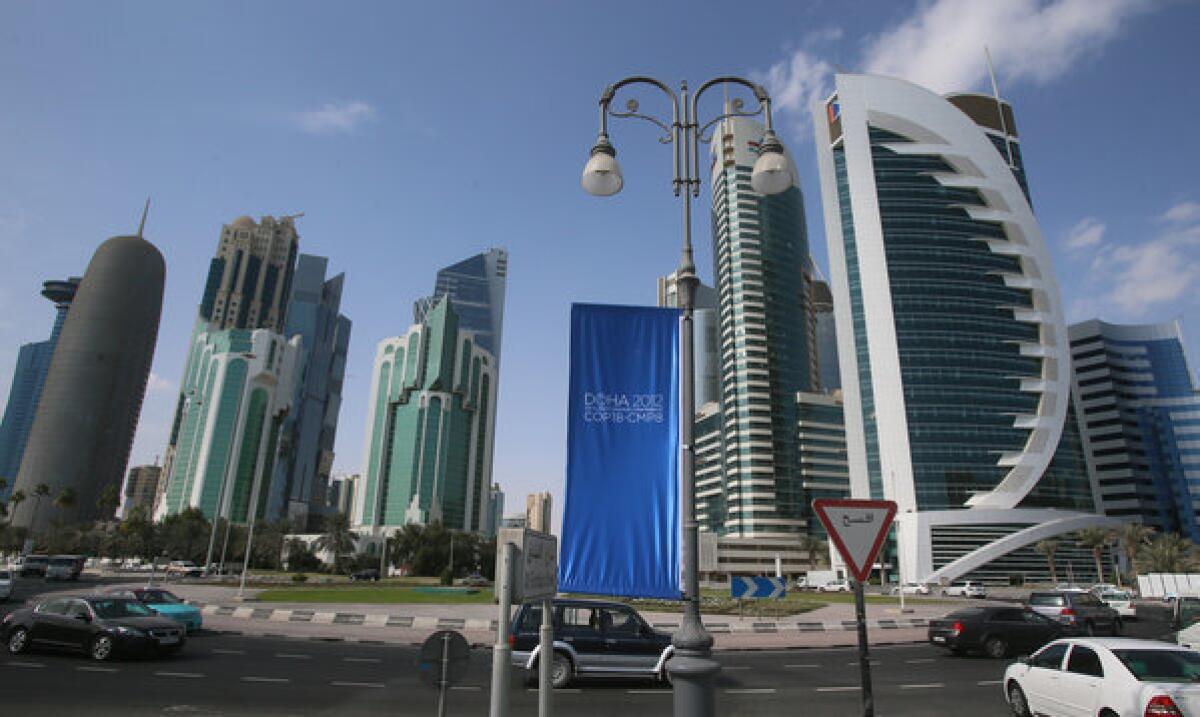Climate talks buffeted by the force of Superstorm Sandy

More than 17,000 people have converged on the Qatari capital for the latest U.N. climate talks, but the most influential presence may be Sandy.
The superstorm that ravaged the U.S. Northeast a month ago seared into the American consciousness an apocalyptic vision of what climate change could look like. On the heels of devastating wildfires, droughts and floods this year, Sandyâs destructive power snapped Americans to the reality that rising temperatures are a risk to their own well-being, not just a concern for distant lowlands.
Sandyâs fresh reminder of the potential consequences of global warming has been a dominant theme in the first days of the two-week meeting in Doha of the United Nations Framework Convention on Climate Change, delegates report.
Still, politicians and environmentalists at the gathering, which began Monday, maintain low expectations for the massive confab to spur swift or dramatic action to combat rising global temperatures. They predict that, at best, the unwieldy forum drawing together 195 countries and nongovernmental parties will bring agreement to formalize plans to negotiate new climate objectives that follow the aims of the 15-year-old Kyoto Protocol, ostensibly to be achieved by 2020. The next pact doesnât need to be completed until 2015, so the international body is operating without the pressure of a looming deadline, participants said.
The U.S. chief delegate, State Department deputy climate envoy Jonathan Pershing, said Washington has acted âwith enormous urgency and singular purposeâ and is halfway to meeting its goal of a 17% reduction in emissions from 2005 levels by the end of this decade. The United States has invested deeply in renewable energy, reduced coal emissions and doubled automotive fuel efficiency standards, he said, while reiterating that the U.S. climate agenda would be set and monitored nationally, not by an international forum.
China, the worldâs No. 1 carbon emitter, also signaled the status quo on short-term energy policy. Delegate Su Wei urged the delegates to endorse a new agreement to carry forward the Kyoto goals and commitments, an approach that placed no binding reduction targets on developing nations. It was that imbalance of responsibility that prompted the Bush administration more than a decade ago to withdraw from Kyoto and set its own emissions targets.
In spite of the posture of the worldâs top two polluters, political and environmental delegates said the Doha outlook wasnât entirely grim.
âIn both the United States and China, thereâs more than meets the eye when you talk about what is happening on the ground,â Alden Meyer, climate policy expert for the Union of Concerned Scientists, said in a telephone interview from Doha.
He pointed to progress by China in reducing emissions intensity â pollution per unit of energy produced â by shutting down the dirtiest coal plants and building up its renewable sector. On the U.S. side, $90 billion in stimulus spending on clean energy has allowed a doubling of electricity output from renewables and forced automakers to build cars that get better gas mileage.
But China and the United States arenât keeping pace with the smaller countries that are global leaders in generating power from clean sources, the experts say.
âThe United States and China have the most to gain from clean energy technology,â if they want to be competitive with smaller countries currently at the forefront in building massive solar, wind and wave energy projects, said Dan Kammen, director of the Renewable and Appropriate Energy Laboratory at UC Berkeley.
âGermany, Denmark, Korea and others have really been scaling up their green technology, both in production and deployment, and benefiting from the push and pull of technology,â Kammen said. Despite being the incubators of smart energy technology, âboth the United States and China have failed on that.â
Kammen also worries that both economic giantsâ wealth of indigenous fossil fuels â coal in China and natural gas and oil in the United States â is steering domestic investment away from renewables like wind and solar that are on the verge of becoming more cost-effective.
Elliot Diringer, executive vice president and climate expert at the Center for Climate and Energy Solutions, expects little more from Doha than endorsement of the plan proposed a year ago to negotiate a new climate blueprint by 2015 that would set goals beyond Kyotoâs 2020 targets.
A World Bank report last week showed the climate conference mission faltering in its aim of keeping the global temperature from rising more than 2 degrees C (3.6 degrees F) over pre-industrial times. The current pace of carbon emissions threatens to cause at least twice that rise, the World Bank and a parallel report by the U.N. Environmental Program warned.
How to get world powers focused on reining in emissions is a conversation just getting started at Doha and likely to move in fits and starts toward the 2015 deadline for a post-Kyoto agreement, said Nathan Hultman, Brookings Institution international climate policy expert.
âBut the discussion in the United States is different now, even from a month ago,â he said, citing Sandy. âThat demonstrated to a large part of the country that we are certainly vulnerable to the kind of events we might see under climate change. People see now that it is related it to our national security.â
ALSO:
Yasser Arafatâs grave dug up in poisoning probe
Egyptians pour into Tahrir Square to protest presidential decree
Kim Jong Un âsexiest man,â Onion says; Chinaâs Peopleâs Daily buys it
A foreign correspondent for 25 years, Carol J. Williams traveled to and reported from more than 80 countries in Europe, Asia, the Middle East and Latin America.
More to Read
Sign up for Essential California
The most important California stories and recommendations in your inbox every morning.
You may occasionally receive promotional content from the Los Angeles Times.











